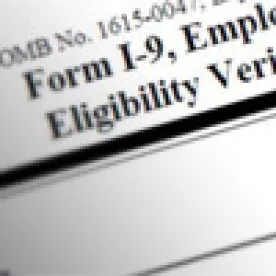On July 17, 2017, U.S. Citizenship and Immigration Services (“USCIS”) issued a revised Form I-9. The new form must be used by September 18, 2017.
The revised form has only one substantive change. A new List C Document was added as an acceptable document – a Consular Report of Birth for a U.S. citizen who was born abroad.
The new I-9 form can be accessed here.
Employers must maintain a completed Form I-9 on file for every employee on their payroll who was hired after November 6, 1986 and for terminated employees during the required retention period. The purpose of the Form I-9 is to require the employer to establish the employee’s identity and authorization to work in the U.S.
Below is a helpful checklist that Sheppard Mullin developed to help employers better understand and comply with the I-9 process.
I-9 CHECKLIST FOR ONBOARDING AND REVERIFICATION
Form I-9
Use the latest form dated 07/17/2017. It is mandatory starting September 18, 2017.
Employees Covered
The employer must have an I-9 on file for all employees hired after 11/06/1986. Employees who were hired on or before that date are exempt from the I-9 requirements.
Timing of I-9
Once you have decided to extend an offer, the I-9 may be presented to the individual either at the same time a written job offer is made, or after the written job offer is accepted and signed. But do not give an applicant an I-9 form at the same time as a job application as that could potentially give rise to a discrimination claim if they are not hired.
Employee Timing
The employee must fill out Section 1 of the I-9 no later than the first day of employment.
Employer Timing
The employer must complete Section 2 of the I-9 no later than the 4th day of employment – 3 days after the first day of employment (the so-called “Thursday rule”).
It is permissible and a best practice to try and get the I-9 completed before the first day of employment. That way, if someone is not work authorized, they are kept off the payroll altogether, rather than finding out on Day 4 (or later in the case of E -Verify since E-Verify employers must give an employee 8 business days to resolve a Tentative Non Confirmation (TNC).
Selection of Documents
The employee gets to choose which work authorization documents they will present to the employer – either one from List A or one from List B and one from List C. You should provide the employee with the Form I-9. The last page has the List of Acceptable Documents which advises them what documents they may choose from to submit as evidence of work authorization. (Foreign nationals have more restrictions on which documents they can tender. More info on that further in this memo).
Original Documents
The employer is required to examine the original work authorization documents provided by the employee. A photocopy or digital scan will not suffice. The employer must request and examine the original. This means that you cannot verify an employee remotely using digitally scanned or faxed documents. For a remote employee, you can authorize someone near them to complete Section 2 and have them sign the I-9 on behalf of the company.
If the documents look real and relate to the employee, then that is sufficient. The employer is not held strictly liable if it turns out that a document that looked real at the time of hire is later identified by ICE to be a fake document.
Completion
Make sure the I-9 is completely and accurately filled out by both the employee and your company. Take the time to carefully review the answer for each field of the form. Make sure the employee signs and dates Section 1.
At the bottom of Page 1, the employee should also check off if they did or did not use a third person to prepare the I-9 for them or translate for them.
Make sure the employer signs and dates Section 2 and indicates the Date of Hire.
Frequently fields are accidentally left blank which makes the I-9 non-compliant.
Making Photocopies
It is also suggested to make copies of the original documents and staple them to the I-9 as further evidence that the original documents were actually examined and that the documents appeared real. If this is done, it must be done for all employees.
Expired Documents
The documents must be valid at the time of hire. There are only three exceptions: (1) a 90 day grace period for new hires that are U.S. Citizens or permanent residents that have already applied for a replacement document – i.e. a replacement of a U.S. passport, state driver’s license, etc. (2) For permanent residents that have an expired green card but have an I-797 receipt notice from USCIS temporarily extending their green card or an I-551 stamp in their passport as temporary evidence of their permanent resident status (3) certain foreign nationals that have an expired employment authorization document (EAD) and an I-797 receipt notice showing a timely filing for an extension.
Additional Information Field
In Section 2 in the middle of the page, there is a large box titled “Additional Information”. The employer may notate unusual situations there.
Four Types of Workers
The I-9 form divides up the workforce into 4 categories – U.S. Citizens, U.S. Nationals (Samoa and Swain Island), permanent residents, and aliens authorized to work for a limited duration. Aliens (foreign nationals) must be very carefully tracked since their work authorization will expire – i.e. work permits and work visas.
Restricted Social Security Card
A restricted social security card is never valid for I-9 purposes. If the social security card says “Not Valid Without DHS Authorization” or similar language, then it cannot be accepted as a List C Document. The employee must tender alternative documents otherwise they cannot be hired. Only unrestricted social security cards are acceptable.
AB 260 Drivers License Not a Valid List B Document
In California, an undocumented individual can apply for an AB 260 driver’s license to allow them to drive. Although this is an identity document, it is usually given to someone who is not work authorized. Therefore it cannot be used as a List B document for I-9 purposes. And the AB 260 driver’s license says in the upper right hand corner “Federal Limits Apply”
Sponsored Work Visas and I-94
For foreign nationals who are working on an employer sponsored work visa, the only documents that will satisfy the I-9 requirements are their passport (a List A identify document) and their I-94 (which shows their date of entry, visa classification, and expiration date of their I-94 — which is the last date they can work and stay in the U.S. without filing an extension. They may print their I-94 from the website of U.S. Customs and Border Protection (CBP).
EAD
In addition, for those working with an employment authorization document (EAD), which is a plastic work permit that is not tied to sponsorship from their employer, then they must produce that as a List A document. Other combination of documents won’t satisfy the I-9 rules since a restricted social security card can’t be accepted and those on EAD’s have restricted social security cards.
Automatic Continuing Work Authorization
In certain instances, there is automatic continuing work authorization for a limited period of time for certain foreign nationals who have timely filed for an extension of their employment authorization document (EAD) (i.e. TPS, H-1B, L-1) etc. For a list of categories that have automatic continuing work authorization for someone that has an EAD, Click here.
Also certain sponsored work visas can receive automatic continuing work authorization after timely filling an extension with USCIS, usually for 240 days after filing.
In unusual situations, contact counsel before terminating.
Reverification
Employers should not reverify the I-9 of an existing employee who is a U.S. Citizen or permanent resident with a plastic green card merely because their documents have expired since they were hired.
For permanent residents, it doesn’t matter if the plastic green card is valid for 10 years or 2 years. If it is valid at the time of hire, then you should not reverify them in the future merely because the date on the plastic green card has expired.
However, foreign national workers with temporary employment authorization must be carefully tracked and timely re-verified prior to the expiration of their I-94 or work permit. The employer would complete Section 3 for reverification.
Rehires
For re-hires within the past 3 years, the employer does not need to complete a new I-9. The employer only needs to fill in Section 3. However, if a new I-9 form has been issued since the original hire, then Section 3 on the new I-9 form should be completed and stapled to the old one.
Name Change
It is not required that an employer update an I-9 when an employee changes their name due to a marriage or divorce. However, if the employee requests it, Section 3 could be used. Additionally, a comment can be added to the “Additional Information” Box in Section 2.
If the name change is due to a situation where the employee used a false name and SSN at the time of hire (but the documents appeared real to the employer at that time) and the employee subsequently legalizes and advises the Employer of the situation, then the employee and employer should complete a new I-9, and the employer should explain the situation in Section 2, copy the new work authorization documents, and staple everything together.
Spanish I-9
The Spanish I-9 is only valid for us in Puerto Rico. Do not use it in the 50 states.
Use of Preparer and/or Translator
After the employee signs and dates Section 1, they should check off the box below that to indicate if they did or did not use a preparer and/or translator to complete the form. If the employee did use someone else to help them complete the I-9 or the person acted as a translator, then the preparer/translator should complete that section.
Retention:
Maintain the I-9 records throughout employment and for 3 years after termination. This is a simplified version of the retention rule, but it avoids accidental premature destruction of I-9’s for terminated employees.
Keep all your I-9’s in binders
Do not keep the I-9 in the employee’s HR file. Separate current employees from terminated employees and keep them in separate binders labeled “Current Employees” or “Terminated Employees”. In the event of an I-9 audit by Immigration & Customs Enforcement (ICE), this will make it much easier to produce them within the 3 days requested by the agency.
Paper vs. Digital I-9’s
You can also scan and make a digital copy of the paper I-9 at the time of hire or reverification, but the original paper version will be the official version, unless you convert to an all-digital I-9 software program using a reliable vendor that conforms to ICE’s digital I-9 software protocols. If you do so and it conforms to ICE protocols, then the digital version will become the official version but we still recommend you retain the paper I-9’s.
Be advised that the “smart” I-9 form that is on the USCIS website is meant primarily for guidance purposes. It is not a digital I-9 software program that conforms to ICE protocols. So unless an employer has purchases a reliable digital I-9 software program, then they should continue to use the paper version.
Unusual Situations
Do not rely on the employee for advice as to whether they are work authorized. When in doubt, consult with counsel.
Additional Resources from USCIS
I-9 Central (USCIS I-9 Portal) at: https://www.uscis.gov/i-9-central
I-9 Handbook from USCIS: https://www.uscis.gov/sites/default/files/files/form/m-274.pdf



 />i
/>i

